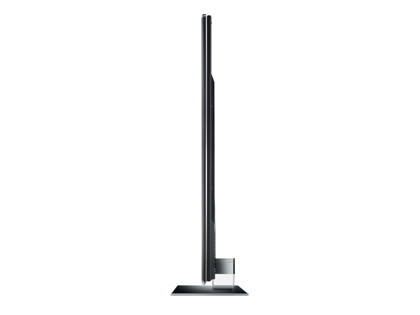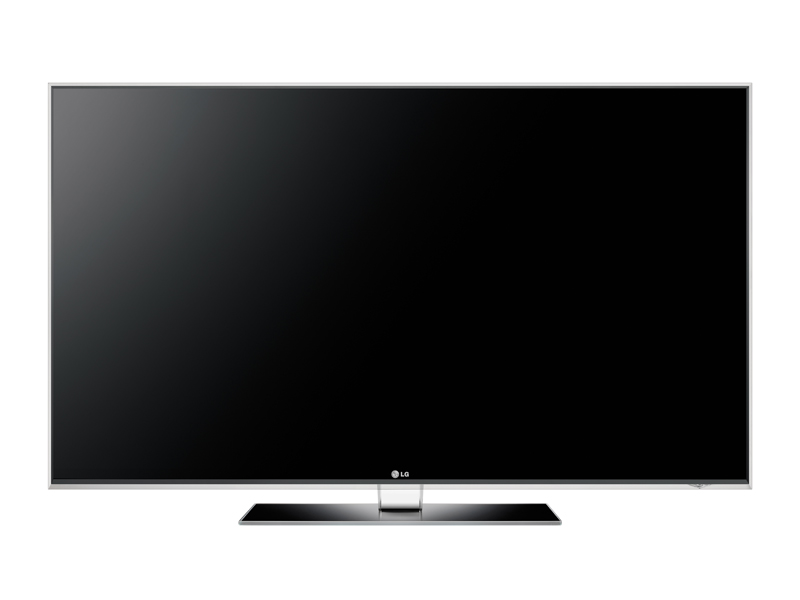Why you can trust TechRadar

LG's European (though not UK) marketers have been talking optimistically about borderless TVs for months now and the 55LX9900 gets mightily close to delivering on this promise.
As well as delivering a visual metaphor for the technological innovations within, the 55LX9900's design is remarkably compact and utterly gorgeous. Especially as the screen sits in the same single plane as the surround, the LG logo beneath the screen subtly illuminates and the desktop stand uses a transparent, cube-like neck to extremely attractive effect.
Spinning the set round to assess its sockets, though, uncovers a concern. For the majority of the connections face directly backwards, presenting a considerable problem for anyone wanting to wall mount the TV. Similarly slim TVs we've seen from Samsung and Sony have both tried hard to keep their connections facing at right angles to the set so you can slide cables in from the side.
To be fair to LG, the 55LX9900 does manage to provide a single side-facing HDMI, two side-facing USBs, a down-facing RF input and a little side-mounted adaptor port for a component video input, with the adaptor for this provided in the box. So it is possible to avoid having connections jutting straight out of the set's rear, particularly if you use an external HDMI switching device, such as an AV receiver, to avoid the other three back-facing inputs. But there's no easy solution for anyone wanting to use the D-Sub PC port, Scart socket or RS232 port.
Maybe LG is trying to push you towards its optional wireless AV system. For if you cough up extra the cash, you can get a wireless media box that enables you to transmit audio and full HD video from your sources without cables, thereby massively reducing the burden on the connections built into the TV.
It might have been nice if this system had been included as standard on such an expensive set, but there you go.
Rather disappointingly, the 55LX9900 doesn't even have built-in network Wi-Fi; this again needs an optional extra bit of kit in the shape of a USB dongle.
The good news in all this, of course, is that, as you may have noticed, the 55LX9900 still has all the connections it needs to cope with today's HD and multimedia requirements. Especially since many of these all offer a wide-ranging set of functions.
The Ethernet port, for instance, can be used to access future interactive services available from the set's built-in Freeview HD tuner. Or you can use it to stream files from a DLNA PC (Nero's MediaHome 4 Essentials PC disc is shipped with the TV). Or you can hook it up to your router for access to LG's new NetCast online service.
The USBs, meanwhile, can play DivX HD video files, MP3 audio and JPEG photos from digital cameras or USB storage devices. And last, but by no means least, the HDMIs are built to the latest HDMI v1.4 standard, as required by the active 3D format.
3D capable
Now that we've mentioned 3D, we should kick off an exploration of the 55LX9900's 3D talents by saying that it doesn't include 2D-3D conversion, but does cover side by side (as used by Sky), top and bottom, checker board and, of course, frame sequential (as used by the latest 3D Blu-ray players) 3D options.
As a side note, we were rather startled by the huge list of cautions when viewing 3D video contained in the TV's manual. These include advice not to watch 3D if you're pregnant, old, or have a heart condition; not to let children under 5 watch 3D as it can 'cause problems to normal vision development'; and not to sit near any fragile or dangerous objects as you might 'confuse the 3D video as reality and suddenly move to cause an injury'.
The advice also suggests that you take a break every five to 15 minutes for every one hour of 3D watched, which is hardly ideal for 3D movie fans.
One very pleasing discovery is that the 55LX9900 ships with two pairs of 3D glasses as standard. What's more, while these specs aren't particularly great at shielding out ambient light, they are reasonably comfortable, certainly more wearable over extended periods of time than Panasonic's current eyewear.
Magic remote
LG hits the innovation trail yet again, meanwhile, with its Magic Remote. This curious-looking device resembles a PC presentation 'wand', and its big trick is that you can point it at the TV, Wiimote style, and choose your options that way rather than using the traditional, less intuitive remote control approach (though a standard handheld controller is also included).
As well as providing a genuinely intriguing way of controlling the 55LX9900, the Magic Remote also comes in handy as an alternative control method for a selection of games LG has included within the TV's memory. We can't go into more detail on this, though, since the sample we tested crashed out and rebooted itself every time we selected the game option.
The NetCast web browsing system is disappointing. The only content on there at the time of writing was the AccuWeather weather forecasting platform, YouTube and the Picasa photo-sharing site. Again, though, these services didn't work properly during our tests, repeatedly causing the TV to reset itself. But assuming they work on the final shop 55LX9900 samples, there's no getting round the fact that the NetCast content level is rather behind the online offerings of Sony, Panasonic and Philips.
As with many other LG TVs, the 55LX9900 is endorsed by the Imaging Science Foundation (ISF), thanks to a formidable roster of picture fine-tuning tools. A colour management system, for instance, enables you to adjust the contrast and brightness of the RGB colour elements, and the saturation and tint of the red, green, blue, yellow, cyan and magenta components. Then there is a series of gamma presets, various levels and types of noise reduction and a multi-setting contrast booster.
The last two features we want to cover are both very significant. The first finds the 55LX9900 boasting 400Hz processing. This doesn't mean the screen really refreshes 400 times per second, mind you; rather the screen refreshes at 200Hz, but is joined by a scanning backlight which makes the 400Hz claim possible, if not strictly accurate.
Samsung uses a similar set up on its C8000 3D TVs, but has elected to stick at the more conservative 200Hz number for its marketing.
The 55LX9900's last trick is local dimming. This enables the TV to control the brightness levels of the individual clusters of LED lights behind the screen, with potentially profound impact on the picture's contrast. In fact, LG claims a contrast ratio of 10,000,000:1 for the 55LX9900, which is even higher than Panasonic's claims for its latest premium NeoPDP plasma TVs.
Current page: LG 55LX9900: Features
Prev Page LG 55LX9900: Overview Next Page LG 55LX9900: Ease of useJohn has been writing about home entertainment technology for more than two decades - an especially impressive feat considering he still claims to only be 35 years old (yeah, right). In that time he’s reviewed hundreds if not thousands of TVs, projectors and speakers, and spent frankly far too long sitting by himself in a dark room.

